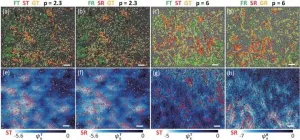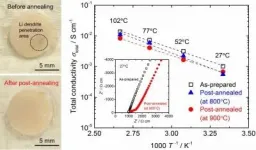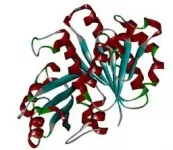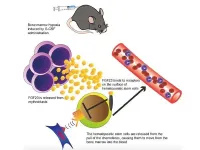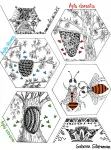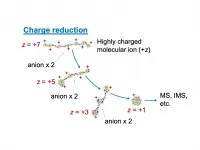(Press-News.org) The psychological well-being of both men and women declined when Denmark closed down during the first wave of the coronavirus pandemic in the spring of 2020 - with women being hit the hardest. But during the second wave, it is the other way round in terms of gender: The psychological well-being of men and women is generally low, but it has fallen most in men.
This is shown in a survey conducted by Søren Dinesen Østergaard, among others. He is professor at the Department of Clinical Medicine and affiliated with the Department of Affective Disorders at Aarhus University Hospital - Psychiatry in Denmark.
The survey is the latest of three assessments of Danes' psychological well-being during the pandemic. The first survey was carried out during the spring shutdown, the second at the end of April after the level of infection had fallen, and the third and recently published survey during the period from 20 November to 8 December last year. The results of the three surveys have been published in the journal Acta Neuropsychiatrica.
"We see that men's psychological well-being is lower in the November-December measurement than it was during the spring lockdown, while the trend has gone in the opposite direction for women," says Søren Dinesen Østergaard.
The 5-item WHO well-being index (WHO-5) is used as a screening tool by, e.g., general practitioners, to assess whether a patient should be further examined for depression. The responses to the five questions in the WHO-5 result in a total score between 0 and 100 - with a higher score indicating higher psychological well-being. If the score is below 50, the probability of depression is substantial.
Søren Dinesen Østergaard explains that the average WHO-5 score in the November-December survey had decreased by just under 4 points for men and 2.5 points for women since the (second) assessment at the end of April. Compared to the first assessment at the end of March/beginning of April, during the peak of the first wave, the psychological well-being has risen slightly, with just under 1.5 points, for women, while it has fallen correspondingly for men. However, there are still more women with scores below 50 on the WHO in the November-December assessment - 27 per cent of women compared to 23 per cent of men.
"Of course, we cannot know for sure that the course of the corona pandemic is the cause of the variations we see in the psychological well-being. But the results fit this explanation. The onset of winter may, however, also play a role," he adds. He points out that it is established that the number of Danes who are diagnosed with depression increases significantly after the transition to winter time. He emphasizes that as it is primarily women who experience seasonal variations in mood, this explanation does not fit well with the fact that the decline in psychological well-being during the second wave of the corona pandemic is greatest among men.
"The gender difference in our results is interesting, but we cannot determine the underlying mechanisms based on the data at hand. Perhaps it has to do with uncertainties related to employment. The job market has been negatively affected by the pandemic, especially the private sector, which occupies more men than women, so perhaps it is a question of men worrying more about their employment prospects and their family's economic situation than women. This is something we will try to address in the next round of the survey," he says.
INFORMATION:
The research results - more information
The study was carried out as a survey conducted by Epinion based on the WHO-5 well-being index. Epinion received payment for carrying out the survey. A total of 2458 people participated in the first part of the survey, and 1554 from the same group participated again in the recently published part of the study. The results are weighted so that they are representative of the Danish population on a number of parameters.
The project partners are: Professor Kim Mannemar Sønderskov, Department of Political Science, Aarhus University; Professor Peter Thisted Dinesen, Department of Political Science, University of Copenhagen; Postdoc Helene Tilma Vistisen, Department of Clinical Medicine, Aarhus University and the Department of Affective Disorders, Aarhus University Hospital - Psychiatry.
Climate researchers have found a simple but efficient way to improve estimations of ultimate global warming from complex climate models. The finding is relevant for the evaluation and comparison of climate models and thus for accurate projections of future climate change - especially beyond the year 2100. The study is published in Geophysical Research Letters by Dr. Robbin Bastiaansen and colleagues at the Institute for Marine and Atmospheric Research Utrecht, Utrecht University, The Netherlands. The work is part of the European TiPES project coordinated by the University of Copenhagen, Denmark.
Complex climate models are rarely used to simulate the effect of global warming for a given amount of CO2 beyond a couple of centuries into the future. ...
A system that uses flexible, breathable magnetic skin allows people with severe quadriplegia to move around and choose their surroundings. Developed by KAUST researchers, the high-tech system relies on the user's facial expressions to accomplish a wide variety of tasks, from moving down the street to using an elevator.
There are a wide variety of assistive technologies for people with quadriplegia, but most systems are not suitable for patients with severe quadriplegia as they often rely on head or neck movements to work. For these patients, the options are limited to camera, tongue control, voice-assistant and neural detector systems. But these either offer a limited range of gestures or are not compatible with outdoor applications. Some also require invasive attachments or ...
Naltrexone, used either alone or together with disulfiram or acamprosate, is associated with a decreased risk of hospitalization due to alcohol use disorder (AUD) when compared with non-use of AUD drugs, a new register-based study shows. The same associations were noticed for hospitalization due to any cause. Disulfiram use and polytherapy with two or more drugs indicated for AUD was associated with a decreased risk of hospitalization due to alcohol-related somatic causes. None of the studied medications were associated with mortality or work disability (sickness absence or disability pension). The study was published in Addiction.
Benzodiazepine use linked to harmful effects
As benzodiazepine use is common among persons with AUD, the ...
Various glass materials have been essential to the development of modern civilization due to their advantageous properties. Specifically, glasses have a liquid-like disordered structure but solid-like mechanical properties. This leads to one of the central mysteries of glasses: "Why don't glasses flow like liquids?" This question is so important that it was selected by the journal Science in 2005 as one of 125 key, unanswered scientific questions, and one of 11 unsolved important physical issues.
We can hardly observe the movements of atoms at a ~0.1 nanometer length scale and a ~1 ...
Overview:
A research team in the Department of Electrical and Electronic Information Engineering at Toyohashi University of Technology and the Department of Chemistry at University of Calgary has investigated the effect of post-annealing for healing Li garnet solid electrolyte degraded by the growth of Li dendrites. The ionic conductivity of the annealed solid electrolyte was slightly lower than that of the electrolyte before annealing but was retained above 10?4 S cm?1 at room temperature. The electrochemical results obtained indicate the possibility of reusing the solid electrolyte degraded by the growth of Li dendrites in another all-solid-state Li battery.
Details:
A ...
Overview:
The research team of the Department of Computer Science and Engineering at the Toyohashi University of Technology and the Institute of Food Biotechnology and Genomics at the National Academy of Sciences of Ukraine have proposed a new drug to treat tuberculosis (TB), utilizing the state-of-the-art molecular simulations. This drug may inhibit the cell division of Mycobacterium tuberculosis (M. tuberculosis) and suppress its growth. In addition, because this drug acts on the enzymes secreted by M. tuberculosis instead of acting on M. tuberculosis itself, M. tuberculosis ...
"The real voyage of discovery consists not in seeking new landscapes, but in having new eyes."
Scientists would vouch for this statement because scientific pursuit has the habit of offering chance discoveries if we think about things differently.
In the lab of Arati Ramesh at the NCBS, the team loves to spy on the structure and sequence of Ribonucleic acids (RNAs; molecules that decrypt an organism's genetic code into protein messages). During one such instance, graduate students in Arati's lab were peering at a family of nickel and cobalt (NiCo RNAs) sensing bacterial RNAs that have a clover leaf-like structure. ...
A Kobe University research group including graduate student ISHII Shinichi and Associate Professor KATAYAMA Yoshio (both of the Department of Hematology, Graduate School of Medicine) have discovered that fibroblast growth factor-23 (FGF23) produced by erythroblasts (cells that are the precursors of red blood cells) promotes the movement (mobilization) of hematopoietic stem cells (*1) into the peripheral blood. Up until now, FGF23 has been known for the role it plays in the kidneys as a hormone which regulates phosphate concentrations throughout the body.
It is hoped that this discovery will enable new strategies to be developed for harvesting hematopoietic ...
It is early in the morning. Ebi and his colleagues try not to twitch as they stare intently at a rectangular box filled with sugary treats. These aren't for them, but for the honey bees that they study. The tiny buzzers toggle between the sugar 'feeder' and the hive, which are a few metres apart. Interestingly, the bees that visit the feeder aren't secretive about this new found food source. They graciously advertise its location to their nest mates and over time more bees are seen buzzing to the feeder.
This behavior has been observed and researched for decades; but still, the question of how bees communicate within the noisy quarters ...
Mass spectrometers (MS) have become essential tools in chemistry and biology laboratories. The ability to quickly identify the chemical components in a sample allows them to take part in a diverse array of experiments, including radiocarbon dating, protein analysis, and monitoring drug metabolism.
MS instruments work by giving the analyte molecules an electric charge, and shooting them through a region of space with a uniform electric field, which curves their trajectory into a circle. The radius of the circle, which depends on the ratio of the molecule's mass to its charge, is detected and compared with known samples. Because the method can only measure this ratio, not the mass itself, excess charges can lead to inaccurate or ambiguous results.
Now, a team of researchers lead ...


